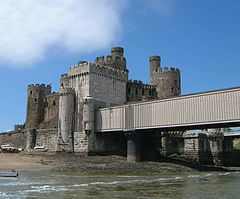Tubular bridge

|
|
| Ancestor | Plate girder bridge |
|---|---|
| Descendant | Box girder bridge |
| Carries | heavy rail |
| Span range | Medium |
| Material | Wrought iron |
| Movable | No |
| Design effort | Very high |
| Falsework required | Depends upon length and degree of prefabrication |
A tubular bridge is a bridge built as a rigid box girder section within which the traffic is carried. Famous examples include the original Britannia Bridge over the Menai Strait and the Conwy railway bridge over the River Conwy, designed and tested by William Fairbairn and built by Robert Stephenson between 1846 and 1850.
The Conwy railway bridge carries the North Wales coast railway line across the River Conwy between Llandudno Junction and the town of Conwy. The wrought iron tubular bridge was built by Robert Stephenson to a design by William Fairbairn, and is similar in construction to Stephenson's other famous tubular bridge, the Britannia Bridge across the Menai Strait. It was officially opened in 1849, but had been completed in 1848. Being the first tubular bridge to be built, the design needed much testing on prototypes to confirm that it would be capable of carrying heavy locomotives, the testing being performed by Fairbairn. The successful result enabled the much larger Britannia bridge to be built. The current Conwy bridge has been reinforced by extra columns under the bridge into the river, but is otherwise virtually unchanged since it was built.
Before the Britannia Bridge was constructed, Fairbairn conducted "the most celebrated of all engineering experiments on the grand scale" a series of experiments "of a gigantic character". One-sixth scale models, 78 ft long, were built at Stephenson's Millwall Works and tested with increasing loads. By this means, although at an experimental cost of thousands of pounds, the design of the cellular girder was refined until it could carry loads of 2.4 times the original capacity. The most significant finding was that of a thin section's susceptibility to buckling under compression loads, and the cellular girder's resistance to this. Stephenson's would build around a thousand other bridges using this cellular structure. The most impressive test was performed on-site at Conway. The 1300 ton tubular girder, deflecting 8 inches under its own weight, was loaded with a further 300 tons and the deflection measured. The effects of wind loading and asymmetric thermal expansion due to sunlight were also studied.
...
Wikipedia
